How To Clean Coffee Pot With Vinegar And Water

The tastiest coffee starts with a thoroughly cleaned java maker. In this post, y'all'll acquire how to naturally make clean a java pot with uncomplicated household ingredients here.
If you're a daily coffee drinker, you may notice that your favorite alloy can get-go to taste bitter or a bit off. No, it's not time to switch to a new roast… it's time to give your coffee maker a cleaning!
The good news? Cleaning your coffee pot is easy and tin be achieved with unproblematic, natural ingredients you lot probably have in your kitchen!

Spring to:
- Definitions
- How Often Should You Clean Your Java Maker?
- iv Ingredients Yous Can Use to Clean Your Coffee Maker
- Ingredients You Should Not Utilize to Clean a Coffee Maker
- How to Make clean a Coffee Maker with Vinegar
- How to Clean a Coffee Maker with Citric Acid
- How to Clean a Coffee Maker with Baking Soda
- How Do Y'all Clean a Coffee Pot
- FAQ
Why Should I Keep My Java Pot Clean?
To put it simply, a make clean coffee pot makes the best java.
You might notice that sometimes your java isn't tasting as expert, the coffee is non brewing a quicky, or there is dust or grounds in your pot. If you lot've experienced any of these issues, it'southward time to clean and descale your coffee maker!
A uncomplicated cleaning will remove difficult water buildup, forbid coffee oils from turning rancid, remove stains from the carafe, and make your coffee sense of taste equally fresh every bit possible.
3 signs your coffee maker needs cleaning:
- Your coffee tastes bitter or gritty. A muddied java auto can ruin the taste of your brew. Java oils left backside during the brewing process can plough rancid making your coffee gustatory modality bitter. This aforementioned residue can build upwardly in the auto leading to greasy build-upwards o the interior lid and filter basket.
- Yous can see white deposits inside your machine.Water contains calcium, magnesium, and other minerals that tin can behind white build-upward (mineral deposits) in your coffee maker. These mineral deposits build upwardly on the insides of the machine and restrict water flow.
- Your auto seems boring or clogged. If your coffee maker takes longer to brew a pot than information technology used to, is louder than normal, spews coffee everywhere, or allows grounds to overflow into the carafe it is suffering from mineral buildup or blockage.
Dingy Coffee Makers Hide Bacteria and Mold.
While having a smashing-tasting loving cup of java is important, you as well want to make sure that your coffee pot is not harboring leaner or mold. Studies of residential java makers take found that they tin get pretty gross without routine cleaning:
- According to the National Sanitation Foundation, the water reservoir (the function of the coffee maker that stores water) tin harbor mold or yeast.
- A study by the University of Arizona found that parts of the java maker (including the handle and the top of the machine) can exist a breeding ground for bacteria and germs.

Definitions
Before nosotros dive into deep cleaning your coffee maker, let's make sure were using the aforementioned lingo! These are 5 terms you lot'll come across in this article:
- Coffee Maker – The appliance in which coffee is brewed either unmarried serve (one loving cup at a time) or multi serving (brews an unabridged pot).
- Coffee Pot or Carafe – The pot with a spout used for both serving coffee and as a receptacle for coffee during the brewing process. (The coffee pots that are sold as part of a coffee maker are ofttimes referred to every bit carafes in American English.) Java pots that come with java makers are normally fabricated of glass, stainless steel, or plastic lined in stainless steel.
- Limescale or Mineral Scale – A white chalky eolith on the inside of pots, tea kettles, drinking glasses, and appliances that use water acquired by the buildup of minerals in difficult water.
- Descale – Remove limescale or mineral build-up from an item.
- Java Build-Up – Oily rest and/or brown sludge or stains left inside the java pot, coffee maker brew basket, and lid during the brewing process. This acidic rest is created by the oils and tannins in coffee grounds.
How Ofttimes Should You Clean Your Coffee Maker?
You lot don't accept to turn into a total germ-a-phobia to keep your coffee maker clean! Follow these simple steps daily, weekly, and monthly to go on your car in meridian working order.
Daily Coffee Maker Cleaning
Rinse the carafe or java pot, brew handbasket, and lids after each utilize, empty the h2o reservoir and allow all the parts to dry completely. Bacteria and mold need a moist environment to grow, if you eliminate the moisture, you eliminate them.
Weekly Coffee Maker Cleaning
Wash all the removable parts of the java maker (the carafe, mash basket, and hat) in hot soapy water once a week to remove as much coffee build up. Cool and unplug the machine so use a damp rag or newspaper towel to wipe the hot plate, drip tray, and outside of the machine. Brand sure to remove as much coffee build upward equally possible.
Deep Cleaning and Descaling
Clean the inside of your coffee maker every 2-4 months using a deep cleaning and/or descaling solution. These solutions can exist made at abode (keep reading to see how you can apply vinegar, citric acid, or baking soda) or they tin can be purchased commercially. Deep cleaning removes the oily build-upward and residue left behind by coffee grounds. Descaling removes the mineral build-upward left behind in the coffee maker from hard water.
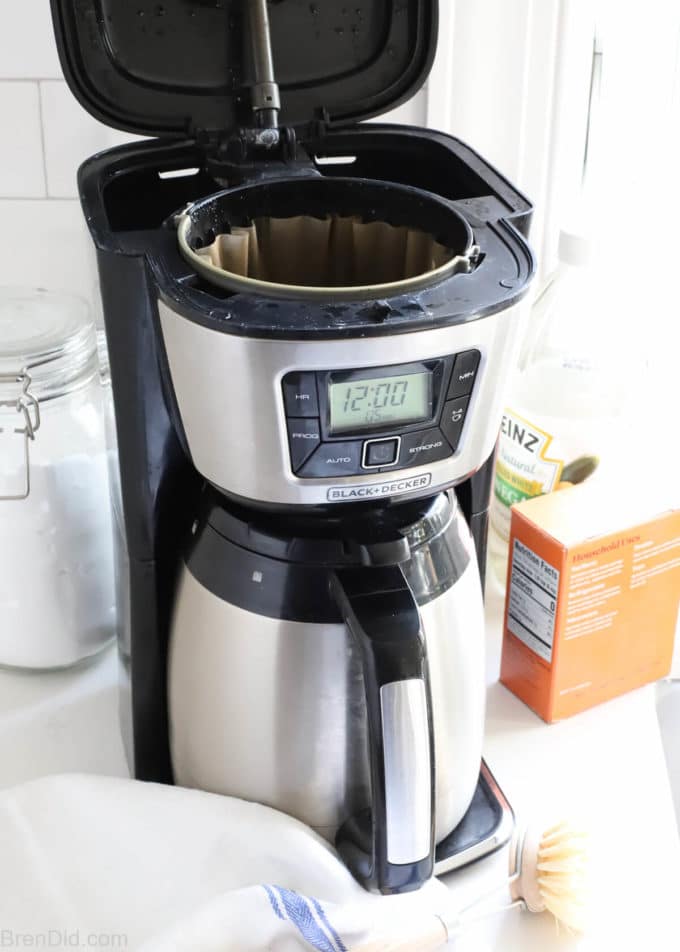
4 Ingredients You Can Use to Clean Your Java Maker
ane. White Vinegar
Vinegar naturally contains acetic acrid which is a weak organic acid. White vinegar is an acidic cleaner that deodorizes and dissolves minerals. It's too used as a natural food preservative to prevent leaner such asE. coli from spoiling food. The white vinegar normally sold in Us grocery stores is a solution of h2o with a 5 percent concentration of acetic acid.
How to use information technology: A solution of white vinegar and h2o volition remove mineral build-up and hard water stains without scrubbing. Employ half h2o and half white vinegar for coffee pot cleaning.
Benefits: Vinegar is widely available, non-toxic, and cheap.
Drawbacks: The vinegar smell from cleaning a coffee machine can linger for a few hours.
2. Citric Acid
Citric acid is a naturally occurring odorless and colorless compound that can be establish in citrus fruits or manufactured. Information technology is an acidic cleaning agent that removes soap scum, difficult water stains, limescale, and rust. It's also used as a flavoring and preservative in nutrient, beverages, processed, and nutritional supplements. Citric acid is commonly sold in U.S grocery stores in the spice aisle or near the canning supplies every bit a white pulverisation that can be dissolved in water.
How to use it: A solution of citric acid and hot h2o will remove mineral build-upwards and difficult water stains without scrubbing. Dissolve 2 tablespoons of citric acid in 64 ounces (half gallon) of warm water.
Benefits: Citric acrid is odorless, not-toxic, and affordable.
Drawbacks: Citric acid can exist difficult to find in U.s.a. stores. I order mine online.
3. Baking Soda
Baking soda (sodium bicarbonate) does not descale java makers, but it is great at removing coffee build-up. It helps remove these brown stains and oils in several ways:
- It is a base (pH eight) that neutralizes the acidic residue left by coffee (pH five)
- Baking soda adds a slight amount of dust that can help physically scrub away stains and residue
- It is a great deodorizer that can assist remove bad tastes and smells.
How to employ it: A solution of baking soda and hot h2o tin can be used after descaling your machine to assist eliminate coffee build-upwards. Dissolve ¼ loving cup baking soda in 64 ounces of warm water, (½ gallon)
Benefits: Baking soda is affordable, not-toxic, odorless, and easy to use.
Drawbacks: Because baking can clog a coffee maker that has mineral build-upwardly, it should only be used to deep clean a coffee maker after descaling.
iv. Store-Bought Cleaners
Commercial coffee maker cleaners can be purchased in stores and online they come up in two basic formulations: cleaners and descalers. It tin have a trivial investigating to come across which you are purchasing because they are often both labeled "coffee maker cleaner."
Cleaners come up in both liquid and powdered form and typically cost $4 to $10 dollars. They contain cleaning agents such as sodium metasilicate, Tetrasodium pyrophosphate, or Sodium percarbonate as the active ingredient. The packet of java maker cleaners will oftentimes say, "remove oily remainder" or "removes java build up" or "removes stans".
Descalers come in both liquid and tablet grade and typically cost $four to $eight dollars per apply. They incorporate some type of acid as the active ingredients to clean and descale your java maker. Some of the acids used include citric acid, acetic acrid, glycolic acid, hydrochloric acid, and formic acid. The packet of coffee maker descalers will frequently say, "removes mineral build-up" or "increases the life of auto" or "eliminates hard water stains".
Benefits: Commercial descalers are widely available and piece of cake to utilize.
Drawbacks: The products can be expensive and due to lax U.s.a. labeling regulations they can incorporate unknown ingredients that are dangerous for human being consumption.

Ingredients You lot Should Not Use to Clean a Coffee Maker
When deep cleaning and descaling your java maker y'all are relying on the baste activeness of the auto to move the cleaner through the internal parts of the car and then use the same drip action to move fresh water through the machine to rinse the parts.
Cull your cleaner carefully to make sure you practise not go out behindrest that tin can impairment your coffee maker or contaminate your coffee.
Exercise Not Apply Poisonous Cleaners
To make sure you do non go out behinddangerous residuum you should NEVER employ cleaners that are poisonous for humans to swallow inside your coffee maker. These include:
- Bleach
- Borax
- Washing Soda
Do Not Apply Residue Depositing Cleaners
To make sure you lot do non get out behind abad tastein your coffee make you should NEVER utilise cleaners that tin can exit rest inside your java maker. These include:
- Dish Soap (can exit behind soap bubbles)
- Lemon Juice (tin can leave behind pulp or natural sugars)
- Apple Cider Vinegar (tin leave behind cellulose or pulp)
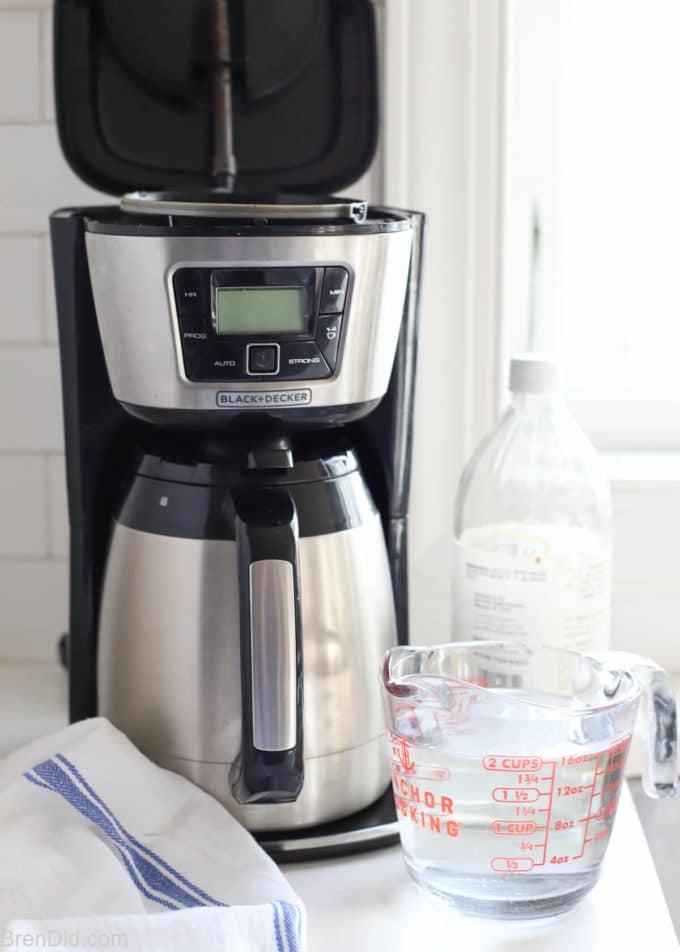
How to Clean a Java Maker with Vinegar
- Empty the coffee pot and grounds. Put auto back together with no filter in identify.
- Brand a solution of ½ white vinegar and ½ fresh water. Fill the h2o reservoir with the vinegar/water solution, put the java pot in place and printing "mash".
- Optional: Halfway through the brew bike turn off the machine and permit it sit for approximately 30 minutes. This allows the vinegar solution to soak the inner parts of the coffee car that may take mineral deposits.
- Let the java maker dorsum on to finish brewing. (If the within of the carafe is stained or has mineral deposits, permit the hot vinegar mixture to stand in the carafe for 30 minutes.)
- Dump the warm vinegar downward the kitchen sink (You'll get a bonus drain deodorizing/cleaning).
- Fill the water reservoir with clean water. Put the coffee pot in identify and press "brew". In one case the cycle is consummate, dump the hot water downward the kitchen sink.
- Let the java maker to cool and unplug. Open the acme and brew basket and use a small brush or rag to wipe abroad any visible hard water deposits or stains. Utilize a damp rag or paper towel to wipe the warming plate, drip tray, and outside of the automobile make clean.
- Reassemble machine and fill the water reservoir with make clean h2o. Put the coffee pot in place and press "mash". Once the cycle is complete, pour the hot h2o down the kitchen sink.
- Check the automobile for a vinegar smell. Run an additional rinse cycle if you can notwithstanding detect an aroma.
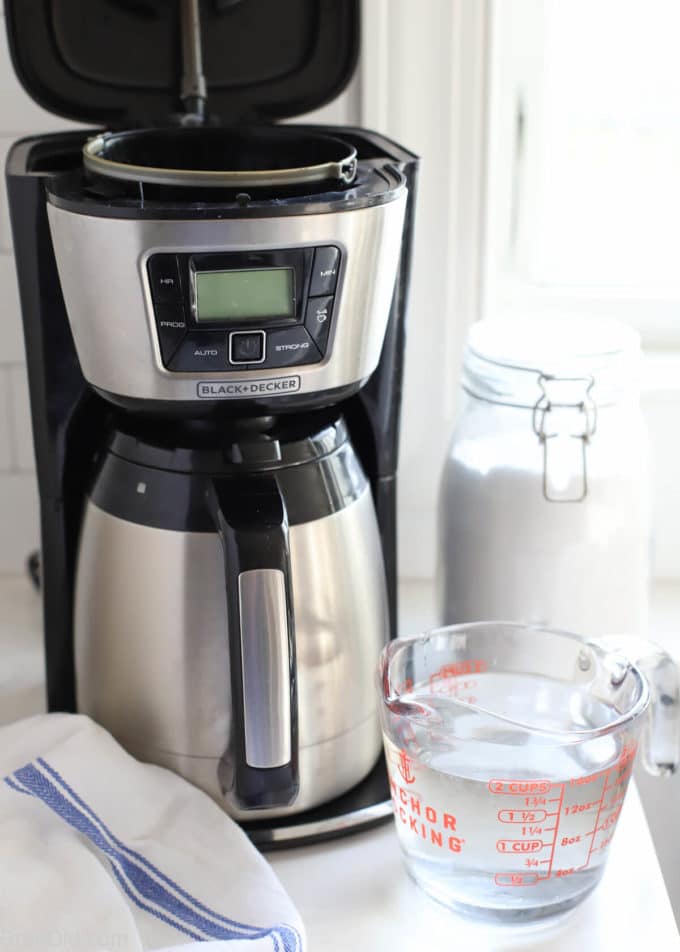
How to Clean a Java Maker with Citric Acrid
- Empty the coffee pot and grounds. Put machine back together with no filter in place.
- Brand a solution of 2 tablespoons of citric acid in 64 ounces of warm h2o.
- Make full the h2o reservoir with the citric acid/water solution, put the java pot in place and press "brew".
- Optional: Halfway through the brew bicycle plow off the auto and let it sit for approximately 30 minutes. This allows the citric acid solution to soak the inner parts of the coffee machine that may have mineral deposits.
- Allow the coffee maker back on to end brewing. (If the within of the carafe is stained or has mineral deposits, allow the hot mixture to stand up in the carafe for 30 minutes.)
- Dump the warm solution down the kitchen sink (You'll get a bonus bleed deodorizing/cleaning).
- Fill the h2o reservoir with clean h2o. Put the java pot in identify and press "brew". Once the cycle is complete, dump the hot water down the kitchen sink.
- Allow the java maker to cool and unplug. Open the top and brew basket and apply a small brush or rag to wipe away any visible hard water deposits or stains. Use a clammy rag or paper towel to wipe the warming plate, drip tray, and exterior of the motorcar clean.
- Reassemble motorcar and fill the water reservoir with clean water. Put the java pot in place and press "brew". Once the cycle is consummate, pour the hot h2o down the kitchen sink.
- Check the machine for an oily or slick residue by feeling within the h2o bedroom. Run an boosted rinse cycle if information technology feels greasier than plain water.
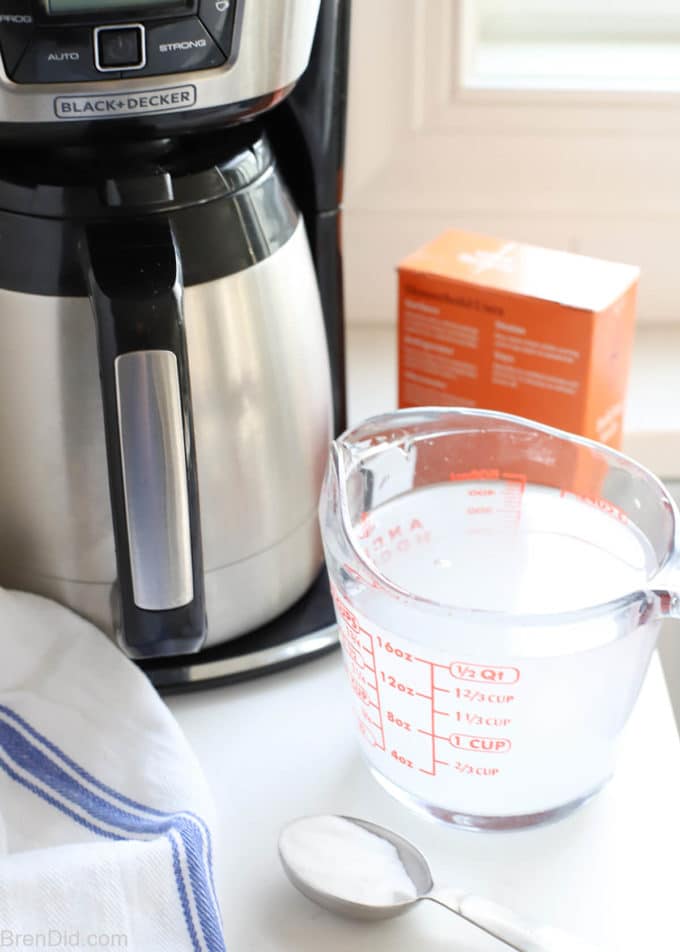
How to Clean a Coffee Maker with Baking Soda
- Descale and make clean the automobile with either vinegar or citric acrid following steps to a higher place.
- Make a solution of baking soda and hot water past dissolving ¼ cup baking soda in 64 ounces of warm water. Make full the water reservoir with the baking soda/water solution, put the coffee pot in place and press "mash".
- Let the coffee maker back on to end brewing. (If the inside of the carafe is stained or has mineral deposits, allow the baking soda mixture to stand in the carafe for 30 minutes.)
- Dump the warm water down the kitchen sink (Y'all'll get a bonus drain deodorizing/cleaning).
- Fill up the h2o reservoir with clean h2o. Put the coffee pot in place and press "mash". In one case the bike is complete, pour the hot water down the kitchen sink.
- Allow the coffee maker to cool and unplug. Open the height and mash basket and use a small castor or rag to wipe abroad any visible coffee residue or stains.
- Reassemble the automobile and fill the water reservoir with make clean water. Put the coffee pot in identify and press "brew". Once the wheel is complete, dump the hot h2o down the kitchen sink.
- Cheque the make clean car for blistering soda residue. Run an additional rinse bicycle if you tin all the same see white residue.
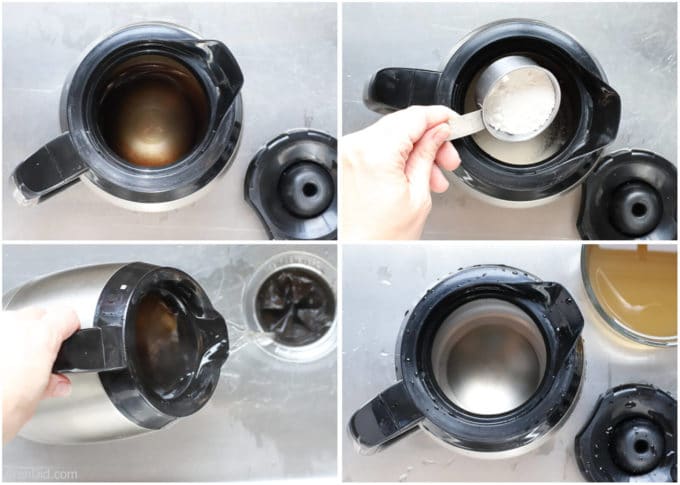
How Do You Make clean a Coffee Pot
You're probably thinking, wait… didn't we just clean the coffee pot? Cleaning the coffee maker (the appliance used to brew java) commonly makes the coffee pot or carafe (the receptacle used to collect the brewed coffee) a lot less dirty, but you may still run into some residual stains or remainder that need a little actress attending.
There are tons of cleaning tutorials online that recommend everything from lemons and rice to denture cleaner to clean the stains from your coffee pot! Luckily the pot (or carafe) is usually easy to rinse make clean so you don't have to worry about build-up or residue (like when washing the inside of a coffee maker), however… some of the recommendations are only a waste product of time and money.
Daily Coffee Pot Cleaning
Rinse the carafe or coffee pot and chapeau with warm water after each use, allow all parts to air dry out completely before reassembling.
Why: A quick rinse keeps java from discoloring the pot. Drying the parts well keeps bacteria and mold from forming.
Weekly Cleaning
Launder the carafe or coffee pot and lid inside and out with hot soapy water and a dish brush, sponge, or cloth. If any stains remain, sprinkle them with baking soda and scrub.
Why: A thorough weekly cleaning with hand washing dish detergent helps remove oily java residue. Baking soda adds abrasive grit to assist remove tough coffee stains.
Monthly Cleaning and Stain Removal
Rinse the pot then add together one/four cup washing soda (sodium percarbonate) or 1/4 cup dishwasher detergent (i detergent pod) into the carafe and fill up with nearly boiling water. Permit mixture to soak for 30 minutes to one hour, drain liquid and wipe stains away with a dish castor or cloth. Rinse well and allow to dry completely.
Why: Deep cleaning the inside of your coffee pot every month using dishwasher detergent or washing soda will remove coffee tannin stains and build up.
Caution! Be careful if using this trick on a glass pot, make sure the pot is warm before pouring the humid water in or the glass could crack. You can warm the pot past filling it with hot tap h2o and then pouring it out.
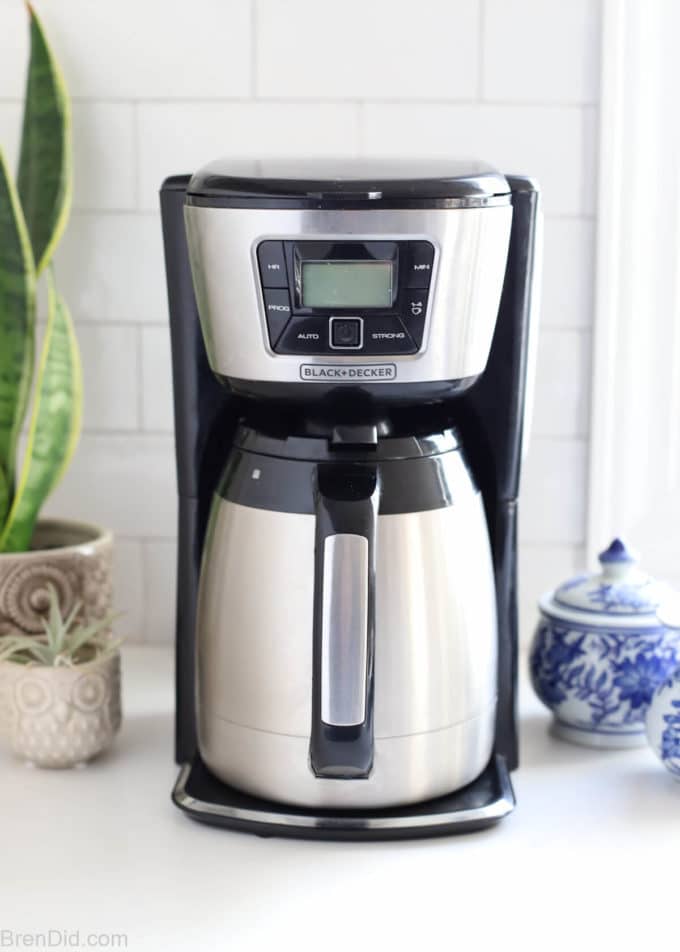
FAQ
Is it bad to clean a coffee pot with dish soap?
Yous tin clean a java pot or carafe (the receptacle that catches the coffee) with dish lather because it can easily be rinsed clean. You should never make clean the interior of your java maker with dish soap because it tin can leave behind a bubbly residuum which will brand the coffee taste soapy.
What is a adept product to make clean my coffee pot?
Vinegar, citric acid, and baking soda can all be used to clean a coffee pot or coffee maker. See detailed instructions higher up.
What should I do to clean a coffee pot that has mold in it?
Remove whatever visible exterior mold with warm water and a rag then follow the steps above to deep clean a java maker with vinegar.
What is the best mode to clean a java pot if you don't have vinegar?
Citric acrid makes a not bad deep cleaner and descaler if you don't accept vinegar. Follow the steps higher up to deep clean a coffee maker with citric acid.
How do yous safely clean a coffee pot without making your house stink?
Utilize citric acid or baking soda to clean a coffee pot with virtually no odor. Follow the steps in a higher place.
Can I clean a coffee maker with apple cider vinegar?
No, apple tree cider vinegar may contain sediment that can become trapped inside the machine. Apply white vinegar or citric acid to safely clean your coffee maker.
A clean coffee maker makes meliorate tasting coffee! I hope you give one of these easy cleaning methods a endeavor!
Dearest iced coffee? Endeavour my piece of cake tip for making certain it never gets weak or watery!

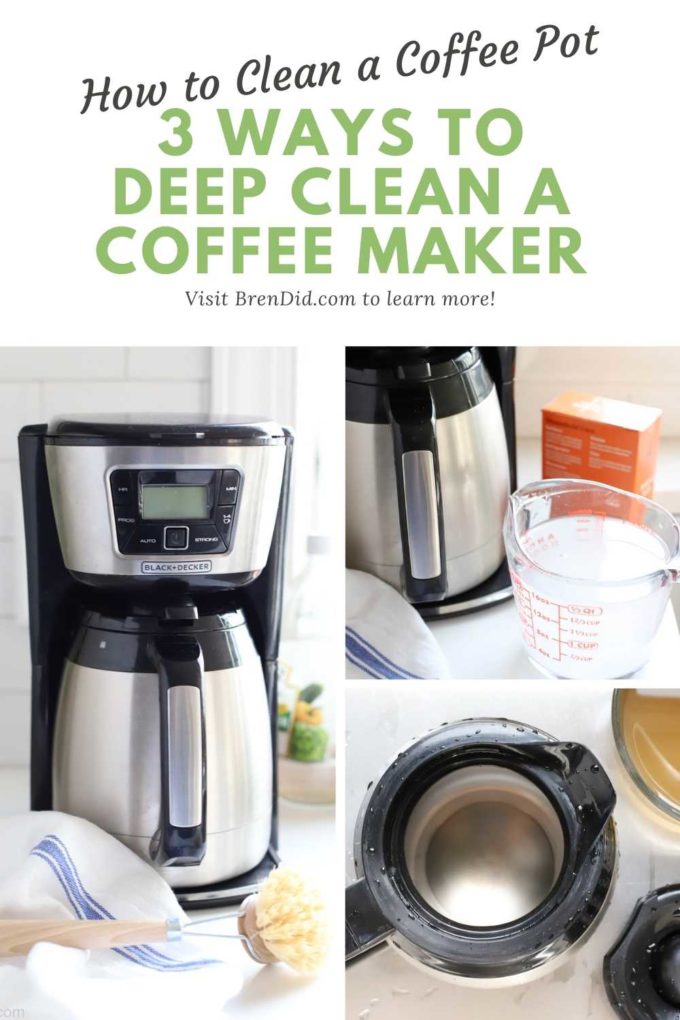
Bren Did Newsletter Subscribers Go Access!

Cheers for subscribing to Green Cleaning & Natural Body Intendance updates! Check your email to confirm your subscription.
Source: https://brendid.com/how-to-clean-a-coffee-pot-3-ways-to-deep-clean-a-coffee-maker/
Posted by: jarvisclinking.blogspot.com


0 Response to "How To Clean Coffee Pot With Vinegar And Water"
Post a Comment